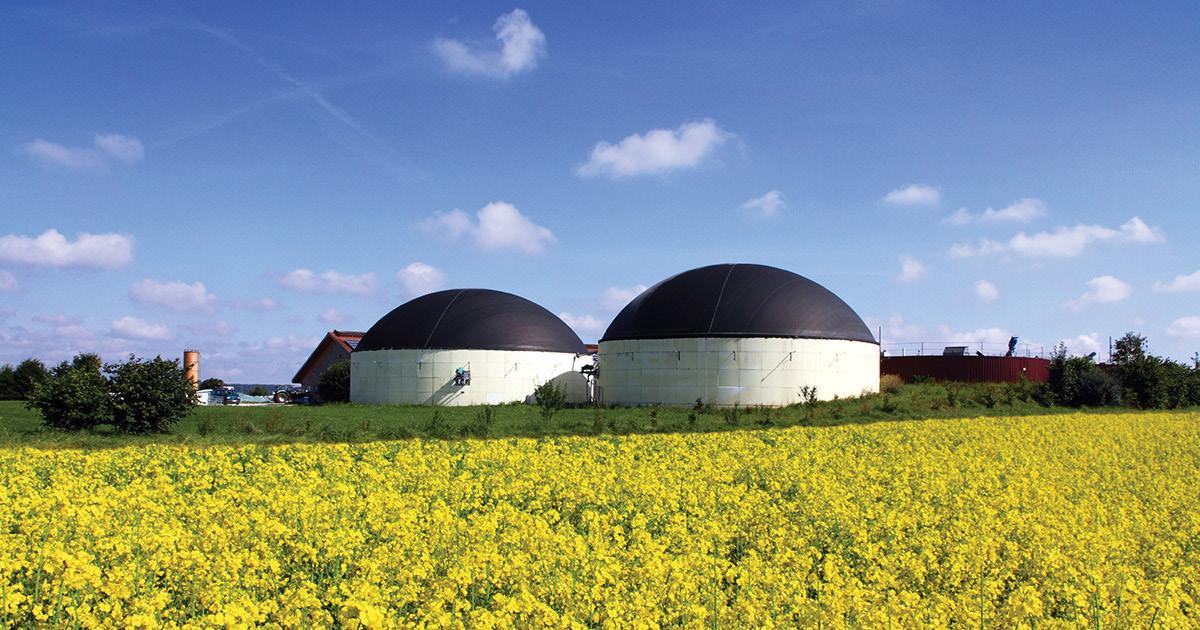
7 minute read
Carbon Offsetting
THE CLIMATE CAN’T WAIT, SO WHAT’S THE SOLUTION? THE CASE FOR 100% CARBON NEUTRAL GAS.
Green tariffs, centred around renewable electricity, have become commonplace within the energy sector. In 2019, renewable electricity provided more electricity to UK homes and businesses for the first time, surpassing all other forms of fossil fuel energy generation. Less than ten years ago, fossil fuel represented four fifths of the UK’s electricity generation.
As renewable electricity becomes the norm - organisations are turning their focus to another component of their energy supply; gas. Solutions for UK ‘green gas’ or biomethane do exist, however, there are currently challenges to delivering this at the scale required to provide the UK with a 100% carbon neutral gas supply.
This article explores the current status of UK green gas, and the alternatives available to those within the energy industry. WHAT IS UK BASED GREEN GAS?
Emissions from the use of natural gas are the primary emissions source in residential and public sectors, accounting for 20% of all carbon emissions in the UK in 2018. As a result, solutions are increasingly being explored to tackle this impact, including UK ‘Green Gas’.
Green gas, or biomethane, is made through anaerobic digestion. This uses bacteria to break down organic materials – like food or farm waste – to release biogas. The biogas is purified and turned into biomethane, which James White, sustainability executive at ClimateCare.
is injected into the gas grid. Once in the grid, it’s piped into homes.
In contrast to natural gas, Biomethane is produced from renewable sources, like food and farm waste and is carbon neutral. Natural Gas reintroduces carbon dioxide (CO 2 ) into the atmosphere that has been locked away for millions of years, whereas biomethane is produced from organic materials that absorbed carbon dioxide while they grew. This means that when it’s burned, it only releases that same amount of carbon dioxide.
In 2019 Green Gas supplied one million UK homes. This was a significant increase since 2017, with this anticipated to surge over the next three years to up to £400m of investment in the sector, according to the UK’s four main gas network operators.
However, Green Gas through Biomethane represents just 4% of the UK’s annual demand for green gas. Supply is not able to meet demand, and unfortunately bridging the gap will take significant time and resource. There is a clear need for an interim solution. And this is where carbon offsetting comes in.
WHAT IS CARBON OFFSETTING?
Carbon offsetting provides a means to mitigate the impact of emissions now. Used by international Governments, businesses and NGOs (and recommended by the UN) many in the energy industry are now exploring how they can use carbon offsetting to compensate for their residual emissions.
Put simply, offsetting means compensating for your carbon emissions by funding an equal reduction in emissions elsewhere in the world. These emissions reductions are generated by projects around the world which adhere to internationally recognised and independently verified standards to ensure that the climate and social benefits they deliver are both tangible and additional. HOW DOES CARBON OFFSETTING HELP THE PLANET?
Carbon Offsetting is a vital tool in tackling climate change, mitigating the impact of emissions we create
now, whilst we work towards reducing the emissions of our activities more concretely. It provides a key means to help us in achieving our ambitions in relation to tackling climate change, helping us to bridge three things: 1. The Ambition Gap: Government ambition is falling short of what is required with regards to reducing emissions to meet the target of 1.5. Following the UN Climate Action Summit, critics noted that 14 high-emitting countries, covering 26 percent of global emissions, currently have no plans to submit new emissions targets ahead of the Paris Agreement coming into full effect next year. 2. Finance Gap: The UN’s
Intergovernmental Panel on Climate Change (IPCC) says that an annual investment of $2.4 trillion is needed in the energy system alone until 2035 to limit temperature rise to below 1.5 °C from pre-industrial levels. (That is around 2.5% of the world’s economy.) At present, “Neither the amount of financial flows nor their direction is sufficient to keep temperatures below 2 °C, let alone 1.5 °C,” says Ottmar Edenhofer, former co-chair of the IPCC’s working group on mitigation of climate change. Additional finance (such as through carbon offsetting) delivers additional finance to the battle on Climate Change, support a low carbon transition globally. 3. Time Gap: There is a consensus that businesses and governments are not acting fast enough to tackle Climate Change. At COP24, United Nations Secretary-General Antonio Guterres stated that the world is “way off course” in its plan to prevent catastrophic climate change, a point he reiterated at COP25. With COP26 currently delayed, climate ambitions are again pushed back, leaving less time to act. Offsetting provides a means to mitigate emissions now, buying us more time to tackle climate change through direct reductions.
The Global Carbon Project found that the total carbon dioxide emissions from fossil fuels and industry amounted to ~33 Gt of CO2 in 2019 (IEA, 2020), giving us less than 20 years before we exceed the target emissions for 1.5-2°C.
Quite frankly, we are running out of time to tackle climate change through solely reducing our emissions.
Carbon offsetting is the only way to take responsibility for current emissions right now, whilst we work out other ways to bridge the time, investment and ambition gap currently being faced in the direct reduction of our emissions HOW DOES CARBON OFFSETTING HELP THE ENERGY INDUSTRY?
Carbon offsetting provides an interim alternative to UK based green gas, allowing industry participants to provide verifiable carbon neutral gas through supporting high impact projects in the developing world.
Carbon offsetting has several advantages in comparison to UK based green gas at present, including: • Carbon Offsetting tends to be more cost effective than UK based green gas, as most carbon offset initiatives operate at large scales in the developing world; • Availability of carbon offset projects is high, with supply of emission reductions sufficient to fulfil demand in the utilities sector; • It’s possible to offset through a wide array of project types which deliver a variety of different impacts. These include protecting biodiversity, improving local people’s livelihoods, and enhancing equality. WHAT DOES SOCIETY THINK OF CARBON NEUTRAL PRODUCTS?
Demand has never been higher for green products. According to a survey conducted by Unilever in 2018, 33% of people were motivated by green credentials in their selection of the products and services they bought. This included utilities.
This number has grown since 2018, with a 2019 study by Futerra suggesting that 88% of people are now looking for brands to provide them with sustainable products and services.
This demand isn’t limited to individual customers either. In fact, organisations, whether large or small, private or public, are also increasing interested in the green credentials of the services and products that they use. A recent Business Green headline suggested that ‘Eight out of 10 small business bosses want to be more sustainable,’ based on a survey of 100 CEOs of British SMEs. The survey found that 84% said they
believe their customers are interested in seeing businesses act sustainably, and 80% said they plan to introduce more ethical/green practices into their business over the next three to five years.
Companies are responding to the above through developing carbon offset gas tariffs, which are designed to engage customers through this demand for high quality green products. This is a trend that we expect to continue, much as utilities suppliers have developed green electricity tariffs in the past. CONCLUSION
Certainly, the future is full of challenges and of course, opportunities for the energy sector. The challenge will be to meet the need of the industry to decarbonise at scale, whilst tackling residual emissions now. All this, alongside creating an offering which captures the interest of consumers and reflects internationally recommended best practice.
There are several different approaches and strategies out there. In my opinion, understanding how best you can combine these for your organisation and to solidify for a leading position within the industry, is something that we would encourage everyone within the industry to consider carefully. https://climatecare.org/
James White develops high-impact programmes for our new partners, based on our trademark Climate+Care approach. His focus is on harnessing the potential for the private sector to be a force for good by creating solutions that work for everyone: companies, communities and the environment. He is proud of the strong relationships he and his team have built across sectors to deliver these solutions. His background is in financial risk management, and James enjoys exploring the natural world on foot or by boat when he’s not at work. REFERENCES: https://assets.publishing.service. gov.uk/government/uploads/ system/uploads/attachment_data/ file/790626/2018-provisionalemissions-statistics-report.pdf IEA 2020 - https://www.iea.org/ articles/global-co2-emissions-in-2019 Greenbiz - https://www.greenbiz.com/ article/world-leaders-commitmentsfall-short-un-climate-action-summit










